
Neijia is the collective name for the internal Chinese martial arts. It relates to those martial arts occupied with spiritual, mental or qi-related aspects, as opposed to an "external" approach focused on physiological aspects. The distinction dates to the 17th century, but its modern application is due to publications by Sun Lutang, dating to the period of 1915 to 1928. Neijing is developed by using neigong or "internal changes", contrasted with waigong or "external exercises".

Tai chi is an internal Chinese martial art practiced for self-defense and health. Known for its slow, intentional movements, tai chi has practitioners worldwide and is particularly popular as a form of gentle exercise and moving meditation, with benefits to mental and physical health.
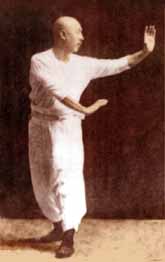
Baguazhang is one of the three main Chinese martial arts of the Wudang school, the other two being tai chi and xingyiquan. It is more broadly grouped as an internal practice. Baguazhang literally means "eight trigram palm", referring to the bagua "trigrams" of the I Ching, one of the canons of Taoism.

The Wudang Mountains are a mountain range in the northwestern part of Hubei, China. They are home to a famous complex of Taoist temples and monasteries associated with the Lord of the North, Xuantian Shangdi. The Wudang Mountains are renowned for the practice of tai chi and Taoism as the Taoist counterpart to the Shaolin Monastery, which is affiliated with Chan Buddhism. The Wudang Mountains are one of the "Four Sacred Mountains of Taoism" in China, an important destination for Taoist pilgrimages. The monasteries such as the Wudang Garden were made a UNESCO World Heritage Site in 1994 because of their religious significance and architectural achievement.

The Sun-style tai chi is one of the five primary styles of tai chi. It is well known for its smooth, flowing movements which omit the more physically vigorous crouching, leaping and fa jin of some other styles. Its gentle postures and high stances make it very suitable for martial arts therapy.
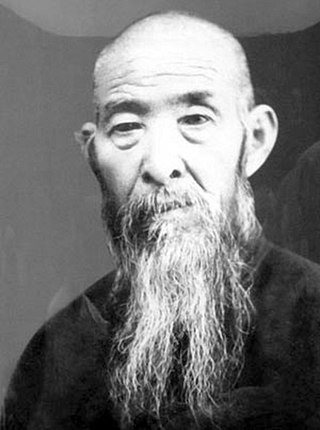
Sun Lutang (1860-1933) was a master of Chinese neijia (internal) martial arts and was the progenitor of the syncretic art of Sun-style tai chi. He was also considered an accomplished Neo-Confucian and Taoist scholar, and was a distinguished contributor to the theory of internal martial arts through his many published works.
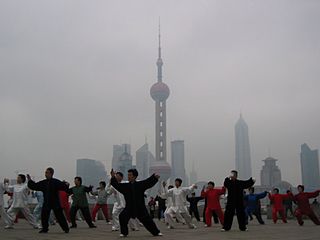
There are hundreds of different styles of Chinese martial arts, each with their own sets of techniques and ideas. The various movements in kung fu, most of which are imitations of the fighting styles of animals, are initiated from one to five basic foot positions: normal upright posture and the four stances called dragon, frog, horse riding, and snake.
Chen Weiming (1881–1958) was a scholar, tai chi teacher, and author. He was also known by his name Chen Zengze (陳曾則), Weiming being his hao, a pen-name.

Cheng Tinghua (1848–1900) was a renowned master of Chinese neijia (internal) martial art baguazhang (bagua).

Fu Zhensong, also known by his courtesy name Fu Qiankun, was a grandmaster of Wudangquan martial arts. He was best known as one of the famed "Five Northern Tigers," and a third-generation master of Baguazhang who founded Fu Style Baguazhang. He was also a soldier and a supporter of Sun Yat-sen.
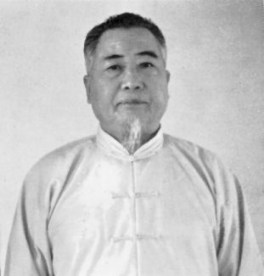
Chang Dsu Yao was a teacher of the martial arts Meihuaquan and tai chi.

Gu Ruzhang was a Chinese martial artist who disseminated the Bak Siu Lum martial arts system across southern China in the early 20th century. Gu was known for his expertise in Iron Palm hand conditioning among other Chinese martial art training exercises. He has become a legendary heroic figure in some Chinese martial arts communities.
Jiang Rongqiao was a famous martial artist from Hebei. His specialized focus in the internal arts led him to develop his own system of Bagua which became recognized and known as Jiang Style Baguazhang.
The Central Guoshu Institute was established in Nanjing by the Kuomintang government of the Republic of China in March 1928 for the propagation of Chinese martial arts, and was an important center of martial arts during the Nanjing decade. Guoshu "national art" was the term for martial arts adopted by the Republic of China at the time. The institute was created by Zhang Zhijiang under the sponsorship of elite government officials such as Li Liejun and others. Along with the Jing Wu Athletic Association, the academy played a crucial role in the transmission of traditional Chinese martial arts into the 20th century.
Wudang Sword is a body of Chinese straight sword (jian) techniques—famous in China—encompassed by the Wudangquan or internal martial arts.
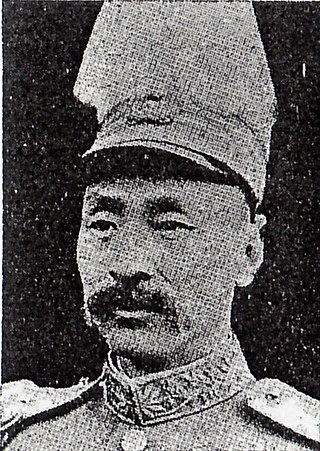
Li Jinglin, also known as Li Fangchen (1885–1931) was a deputy inspector-general and later army general for the Fengtian clique during the Chinese warlord era. He hailed from Zaoqiang County, Hebei province, China. After his military career was over he settled in Nanjing, and in 1927 moved to Shanghai. A renowned swordsman, he was known as "China's First Sword."

Wudangquan is a class of Chinese martial arts. In contemporary China, Chinese martial arts styles are generally classified into two major groups: Wudang (Wutang), named after the Wudang Mountains; and Shaolin, named after the Shaolin Monastery. Whereas Shaolin includes many martial art styles, Wudangquan includes only a few arts that use the focused mind to control the body. This typically encompasses tai chi, xingyiquan and baguazhang, but must also include bajiquan and Wudang Sword. Although the name Wudang simply distinguishes the skills, theories and applications of the internal arts from those of the Shaolin styles, it misleadingly suggests these arts originated at the Wudang Mountains. The name Wudang comes from a popular Chinese legend that incorrectly purports the genesis of tai chi and Wudang Sword by an immortal, Taoist hermit named Zhang Sanfeng who lived in the monasteries of Wudang Mountain. Wudang quan is often used synonymously with Neijia, but Neijia is a broader term that also encompasses Aikido and Qigong, which are not Wudang quan.

Xingyiquan, or Xingyi, is a style of internal Chinese martial arts.
Chan Kowk-wai was born on 3 April 1936, in Taishan in the province of Guangdong, China. He introduced traditional Shaolin kung fu to Brazil through the China-Brazil Kung Fu Academy. His disciples have spread as far as the USA, Canada, Spain, Argentina and the Czech Republic.











